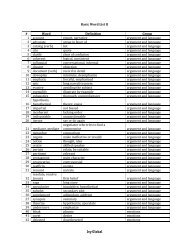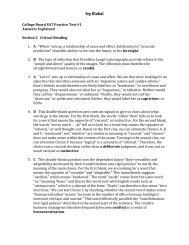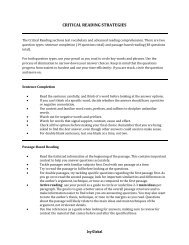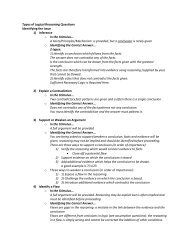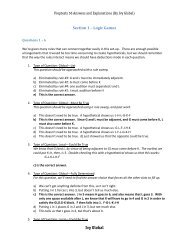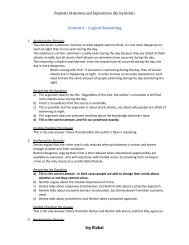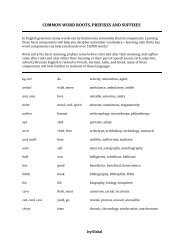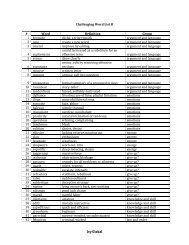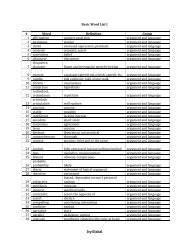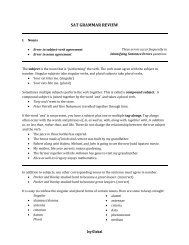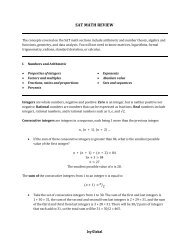Reading Comprehension Answers - Ivy Global
Reading Comprehension Answers - Ivy Global
Reading Comprehension Answers - Ivy Global
Create successful ePaper yourself
Turn your PDF publications into a flip-book with our unique Google optimized e-Paper software.
Preptests 63 <strong>Answers</strong> and Explanations (By <strong>Ivy</strong> <strong>Global</strong>)b) The court used a common-sense interpretation of “traditional,” which eliminated theuse of “within living memory.”c) The problem was with definition, not the regulations.d) The 1910 treaty was not re-investigated.e) This is the correct answer.4. The 1986 court upheld the original FWS standards and definition, which required the itemsto be “commonly practised within living memory.”a) There’s no suggestion of a compromise here.b) This is the correct answer.c) This is what the 1991 court attempted to recognize (that the 1986 court failed to.)d) This is simply untrue, as the practice needed to be both old and recently practised.e) The concerns of the Alaskan Natives were not explored.5. We’ll have to go straight to the answer choices for this question.a) This is the correct answer. Paragraph 3 tells us that the Fur Seal Treaty of 1919prohibited all use of sea otter pelts, and that an exception wasn’t present until the1972 amendment.b) The certain items were not specifically mentioned, and this was a part of the problem.c) We know that Alaskan Natives stopped producing a certain craft at this time, but notwhy.d) The sea otter population isn’t mentioned in the passage.e) There’s no comparison to other animals in the passage.6. The author mentions the Fur Seal Treaty to gives us a history of legislation surrounding thisspecific issue.a) This is not mentioned in the passage.b) Other animals are out of the scope of the passage.c) This is just about hunting sea otters, not other animals.d) Russians are only mentioned in the discontinuation of a specific handicraft.e) This is the correct answer.7. In this case there was an external factor that stopped the handicraft from being created.We’ll need to find something with a situation analogous to the Russian takeover of Alaska.a) There is no external roadblock present here.b) The aspect of this handicraft being commonly practised is not noted and there is noexternal roadblock.c) This is the correct answer. The loss of the herd animals is analogous to the Russiantakeover.d) There is no external roadblock here.e) There is no external roadblock here.<strong>Ivy</strong> <strong>Global</strong>
Preptests 63 <strong>Answers</strong> and Explanations (By <strong>Ivy</strong> <strong>Global</strong>)Questions 8 – 15Analyzing the PassageMain Point:Chopin’s literary style developed throughout changes in the mainstream artistry of sentimentalnovels.Summary:Paragraph 1 introduces us to writer Kate Chopin, who grew up with sentimental domesticnovels, but began writing under the local colorist tradition.Paragraph 2 explores the local colorist tradition, which redefined “women’s culture” in the faceof higher education, professions, and politics, yearning for a nostalgic past.Paragraph 3 tells us that Chopin didn’t really follow the colorist tradition, as she focuses onmore human emotions—but she took from the tradition the use of detached narrative.In paragraph 4, we’re introduced to the New Women movement, which Chopin took a liking to,and really wrote The Awakening in the face of, perhaps to an extreme.Answering the Question8. The main point of the passage is that Chopin’s literary style developed throughout changesin the mainstream artistry of sentimental novels.a) Chopin stayed far away from the sentimental novels of her youth.b) This is the correct answer.c) Other works of fiction are not mentioned as being remarkably different from Chopin’s.d) The opposite of this is true.e) The opposite of this is true—Chopin liked the style of the local colorists, but not thesubject matter.9. Chopin liked the detached style of the local colorists, but not really what they wrote about,or about their nostalgia for the sentimental world of “women’s culture.”a) This is the correct answer.b) Chopin liked the dispassionate observation of characters and used it in her own work.c) We don’t know that the local colorists inspired the New Women.d) In lines 16 – 20 we’re told that the local colorists focused on the new realms thatopened for women.e) Paragraph 3 is all about how their style was to portray extreme psychological states withscientific detachment.10. Chopin adopted a detached stance, according to lines 35 – 37.a) This was sentimental approach.b) Chopin did not approve of this.c) This is the correct answer.d) Chopin used weak plot lines, according to paragraph 4.<strong>Ivy</strong> <strong>Global</strong>
Preptests 63 <strong>Answers</strong> and Explanations (By <strong>Ivy</strong> <strong>Global</strong>)e) This was Chopin’s own addition to her novels, and was not gleaned from any othertradition.11. Traditional “women’s culture” refers to the interests of the sentimentalists—according tolines7 – 10, this was within the realm of courtship and marriage.a) This is the correct answer.b) The local colorists focused on this (lines 35- 36).c) This is not mentioned as an aspect of any of the type of fiction.d) The local colorists focused on this (lines 13 – 16).e) The local colorists focused on this (lines 13 – 16).12. We’re told that Chopin grew up with sentimental novels, but had no desire to follow in thesame vein as them.a) The opposite of this is true.b) Chopin didn’t fully reject the local colorists, nor did she do so because of her dislike ofsentimentalists.c) This is the correct answer.d) These consequences are never mentioned.e) This isn’t needed for the passage; it wouldn’t help it move along in any way.13. There were a lot of similarities between the New Women and The Awakening, but accordingto paragraph 4, Chopin was even more impressionistic. Lines 53- 54 tell us that sheembraced the impressionistic approach even “more fully” than the New Women.a) Both Chopin and the New Women did this (lines 49 – 52).b) Both Chopin and the New Women did this (lines 46 – 47).c) This is the correct answer.d) Both Chopin and the New Women did this (lines 44 – 47).e) Chopin was uneven and disjointed, according to lines 54 – 57.14. The primary purpose of the passage is to describe the development of Chopin’s literary style.a) We’re not told about any aspects of Chopin’s personal life.b) This is the correct answer.c) Chopin is not used as a typified example. The passage is about her; she isn’t used asevidence.d) External social circumstances are not really mentioned as a contributing factor toChopin’s work.e) Other writers are out of the scope of the passage.15. We’ll have to move straight to the answer choices for this question.a) There’s no evidence of novelists’ effect on social customs.b) There is no evidence of this phenomenon in the passage.c) We’re not told about the development of social customs and how they relate to changesin literary styles.<strong>Ivy</strong> <strong>Global</strong>
Preptests 63 <strong>Answers</strong> and Explanations (By <strong>Ivy</strong> <strong>Global</strong>)d) This is the correct answer. In each phase of evolution, a new aspect of women’s lifewas investigated.e) This was the local colorists’ approach that Chopin liked, but that doesn’t make it themost accurate approach.Questions 16 – 21Analyzing the PassageMain Point:Two discoveries have led to a new theory about the spreading of the ocean floor, which lies instark contrast to the formerly accepted theory that the floor remained unchanged.Structure:Paragraph 1 introduces us to an old theory of the ocean floor—that it has remained unchanged.New information is introduced about the polarity of basalt.In paragraph 2, we’re told about the new theory of ocean spreading, and given somebackground information regarding the development of the mid-ocean ridge.Paragraph 3 gives three reasons why the evidence supports the new theory of ocean spreading.Answering the Question16. The main point is that two discoveries have led to a new theory about the spreading of theocean floor, which lies in stark contrast to the formerly accepted theory that the floorremained unchanged.a) This passage is about changes in the ocean floor, not about the formation of it.b) We likely already knew that basalt was magnetic—this discovery just hadn’t beenapplied to knowledge of the ocean floor.c) This is the correct answer.d) This is a detail, from the background information in the first paragraph.e) We started to map the ocean floor, but not for that end in itself—it was a means fordiscovering more about the magnetic properties of the floor.17. The evidence given in the last paragraph is there to bolster the new theory of oceanspreading.a) Rate is not the same thing as correlation.b) We’re not looking to prove that the mid-ocean range exists, but that the characteristicsof it that support the ocean-spreading theory.c) We don’t know what the magnetic field of the earth was believed to be before thistheory.d) This is the correct answer.e) The regularity of the intervals is not supported by the passage.<strong>Ivy</strong> <strong>Global</strong>
Preptests 63 <strong>Answers</strong> and Explanations (By <strong>Ivy</strong> <strong>Global</strong>)Passage AMain Point:Objectivity in historical scholarship requires a separation from external factors likeinterpretation and political considerations.Structure:Paragraph 1 introduces objectivity as an ideal of historical scholarship, and gives us threeassumptions upon which this ideal is based.In paragraph 2, we’re told that the objective ideal is independent of interpretation. Historiansmay ascribe events different meanings, but these meanings are separate from the events themselves.Paragraph 3 compares the role of objective historians to the judiciary—objectivity means onemust be free of external loyalties and biases.Passage BMain Point:Historical arguments should be objective, and objectivity should not be confused with neutrality.Structure:In paragraph 1, the author tells us that objective historical scholarship requires self-discipline.Paragraph 2 explores the distinction between objectivity and neutrality. The author argues thatobjectivity is best embodied by the idea of the “powerful argument,” which values detachment as amethod for reaching an objective argument, not as an end in itself.The author concludes, in paragraph 3, that the best arguments are objective, not neutral, andgives an example of the neutral mechanical TV newscaster.Answering the Questions22. Both of the passages deal with objectivity in historical scholarship, and how the ideal ofobjectivity can best be reached.a) Neither of the passages mentions “serious flaws.”b) This is the correct answer.c) There’s no historical explanation given.d) Passage A mentions relativist historians, but neither passage really makes a judgmentcall on them.e) No historical perspective is given.23. We’ll have to straight to the answer choices for this.a) Other disciplines are not mentioned in either passage.b) Methodologies are not mentioned in either passage.c) This is the correct answer. A mentions it in lines 10 – 11, and B mentions it in lines 31-32.d) The level of detail given in an answer is not mentioned in either passage.e) B mentions this, but A does not.24. We’ll have to go straight to the answer choices for this question.<strong>Ivy</strong> <strong>Global</strong>
Preptests 63 <strong>Answers</strong> and Explanations (By <strong>Ivy</strong> <strong>Global</strong>)a) Author A and author B would likely agree over this.b) This is the correct answer. B would agree with this (see lines 34- 35) and A woulddisagree with it (see lines 20 – 21).c) No historical perspective is given in either passage.d) Both authors talk about propaganda, but neither speaks to it as being essential.e) There’s no exploration of historical changes.25. We’ll have to go straight to the answer choices for this question.a) Neither author makes a judgment call about whether or not historians can actually beobjective.b) This is the correct answer. Both authors focus on the importance of objectivity.c) Author B would disagree with this—she states the opposite at lines 34 – 35.d) There is no judgment call about whether or not historians can evaluate their ownobjectivity.e) There is no judgment call about the number of historians who are objective.26. Both passages touch on propagandist historians as the opposite of the ideal objectivist.a) We don’t hear from proponents of a rival approach in either passage.b) Fields other than history are not mentioned in either passage.c) There’s no suggestion that propagandist history was ever credited.d) This is the correct answer.e) Other kinds of writing are not mentioned in either passage.27. Both authors point out the difficulties in being objective in order to advance their own theoryof historical objectivity.a) Neither passage gives any specific example of failed objectivity.b) Recent developments are never mentioned.c) Opposing arguments are not brought in.d) Other fields of scholarship are never mentioned.e) This is the correct answer.<strong>Ivy</strong> <strong>Global</strong>




